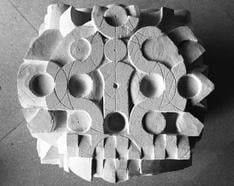
Gabriel Orozco (b. 1962, Jalapa) draws inspiration from the rich and diverse places he has visited and lived in, often using found materials and drawing from local artisan practices to mine artistic value from his nomadic lifestyle. Since 2014, Orozco has been living and working in Asia, splitting his time primarily between Tokyo and Bali, while he also continues to travel and work in New York and Mexico City. His new body of work spans small-scale limestone sculpture, relief carving, ink drawings and tempera painting, and reflects his ongoing interest in local techniques and materials native to the Asian continent.
Flows of movement, connectivity and spatial traces have been ongoing formal concerns for Orozco since the early 1990’s. To express this, he has been applying circles in many different configurations to a wide array of both found and made surfaces. What had only been a line is now a complete body, marrying the notions of the circle in Zen Buddhism. These motifs appear in his work Link Waves (2017), a new painting on canvas, which follows a similar system of formal rules and patterns—based on the game of chess—as the artist’s Samurai Tree (2014–present). The new work marks a departure from a purely circular composition and instead takes on the shape of a cross through a grid-like design that expands from the center outwards in limited color variations determined by the set of rules marked by this game. The self-imposed limitations are the way in which Orozco explores the possibilities of creativity through calculation.
A series of new limestone sculptures from 2017; titled Dés (the french word for dice), follow the same compositional principle, in this case working with the third dimension of depth. Each Dé is meticulously hand-carved and explores the variations of ‘empty’ and ‘full’ in ways that painting can only do with color. For the artist, emptiness is considered a form of construction—seen in works such as Empty Shoe Box (1993), Yielding Stone (1992), Breath over Piano (1993), or Extension of Reflection (1992)—which focus on space and on the residues bodies leave behind from their motion. A material representation of this process of composition is embodied in limestone carving, which has been central to Orozco's research in Bali. Responding to his interest in this type of material and the technique of slow and very detailed engraving, for this series of sculptures and to fully embrace the process, the artist attended a stone-carving workshop, collaborating with local trained craftsman.
Orozco, fascinated by the possibilities of limestone and the knowledge of the carvers, also produced a piece that represents his interest in the antique cuneiform reliefs from Mesopotamia and carved hieroglyphs from Egypt and the Mayans. The script carved into the stone turns it into a material form that occupies space. Writing is initially linear and flat, however literature weaves in depth, history, and context into the surface, allowing it to be perceived as multi-dimensional. Through this relief, Orozco explores how a sculpture can embody literature: a concrete body that tells a story through the lines and circles it has been engraved with.
Finally, a series of ink drawings demonstrate a more free-flowing creative process. Conceived and produced as one set per day, each complete work consists of nine pages drawn from Orozco’s sketchbook. The artist starts off with one figurative ink drawing of a skull, a recurring motif in his work since Black Kites (1997), which soaks through the rest of the pages. Orozco then works on each one, from the first purely figurative to an abstract variation of the initial form. The daily exercise is reminiscent of automatic drawing, allowing the subconscious to be expressed on the pages, and allowing chance to become part of the diaristic process.
Orozco's life journey is visible on the surface of his works. His explorations of place and culture translate into his creative process in what could be considered a multifarious travel notebook. At this point of the voyage, Asia is the center of his attention, yet his vision speaks a global language that gains meaning wherever he resides. The constant shift of his residence has been the pivotal force of Orozco's continuous renewal in art making.
For Art Basel Hong Kong 2018, kurimanzutto will present a solo exhibition of new works by Gabriel Orozco all of which the artist made in the past few years while living in Asia.